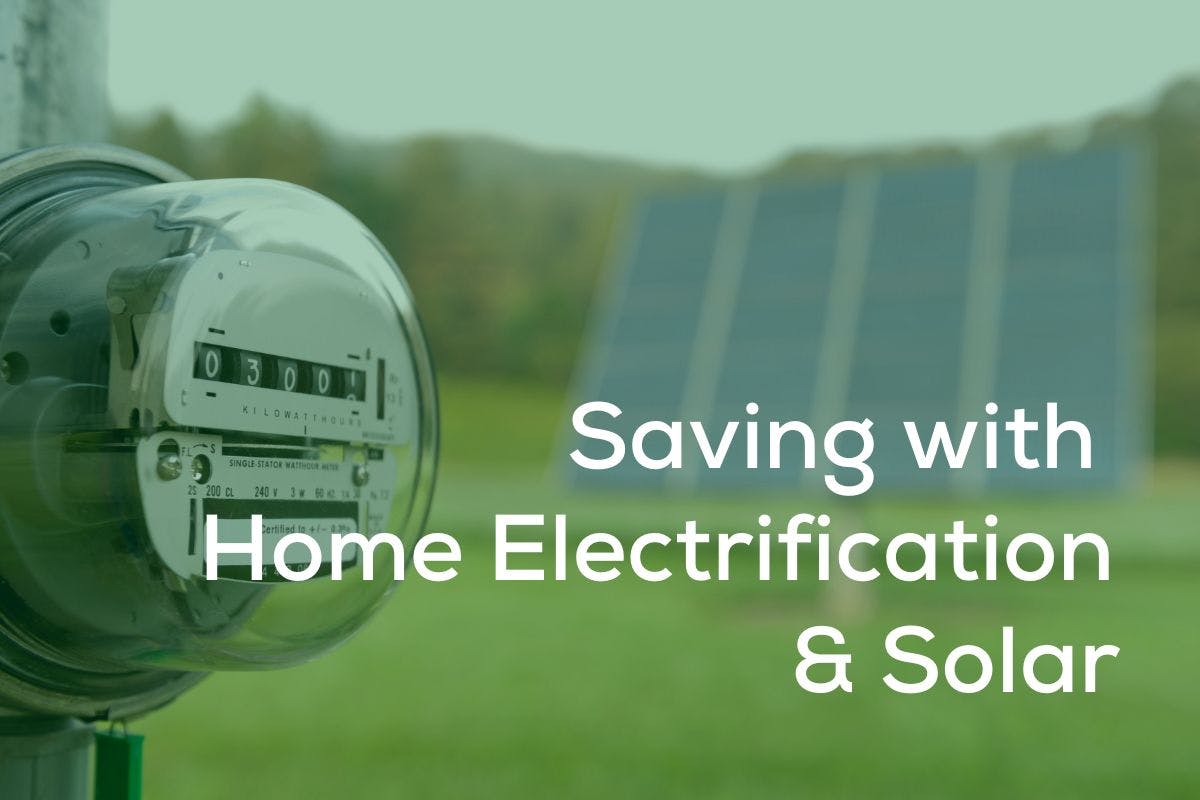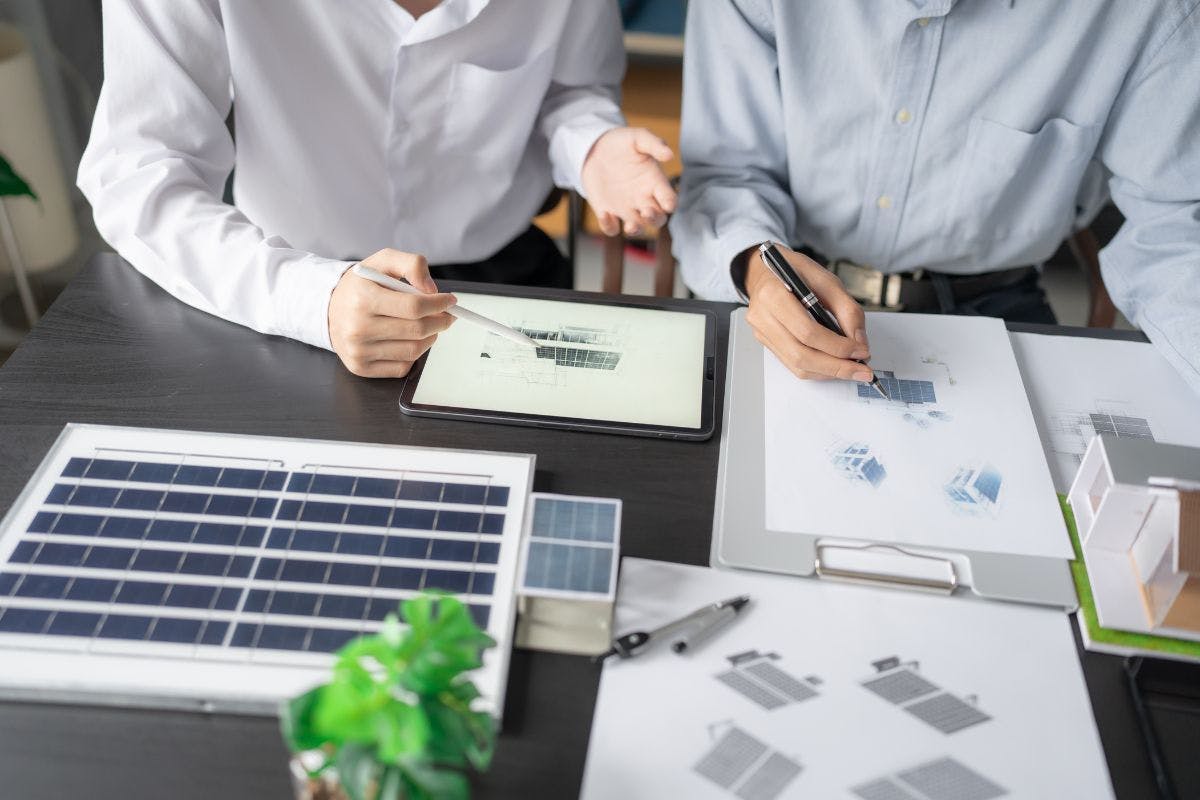Solar and Home Electrification: How They Can Save You Money
Actualizado

Autor
Andrew Blok
Writer and Editor

Editor
Andrew Giermak
Writer and Editor

In a time of rising costs, we’re all looking for ways to save.
Home electrification — the process of swapping out all your fossil fuel appliances for electric ones — paired with home solar panels can help you cut back on one major home expense: your energy bill.
Besides saving you money, solar and electrification are two of the best ways homeowners can reduce their climate impact at home. Here’s how solar and electrification can reduce your bills.
See how much you can save by going solar with Palmetto
Home Electrification 101
The International Energy Agency defines electrification as "replacing technologies or processes that use fossil fuels with electrically-powered equivalents."
Today, many people associate electrification efforts with shifting from internal combustion engines to electric vehicles (EVs) at ever-increasing rates.
But home electrification is just as important, both for the environment and for affordability.
Key components of home electrification
Although every home electrification roadmap will look slightly different, the basic process is based on three main principles:
- Remove and replace all fossil fuel-powered appliances with electric alternatives.
- Increase the energy efficiency of your home.
- Explore ways to further reduce or replace utility electricity consumption.
Electric bills and electrification
Making sustainable upgrades at home can be difficult if the renovations are too expensive.
After all, appliance replacements aren't free and adding electric appliances can increase your electric bills, even as it decreases or eliminates your bill for gas or another fossil fuel.
But, electrification can save homeowners money when paired with solar and efficiency. No one is going to drill for and refine their own fossil fuels, but millions of people are generating their own electricity with solar panels.

How to Reduce Energy Costs While Electrifying Your Home
When embarking on the journey to lower electricity bills, it's best to think long-term. Although energy-efficient upgrades can come with high price tags, these improvements can create real savings on your utility bills and increase your property value.
Home energy audits
A professional home energy audit (or home energy assessment) provides a full analysis of your property's utility bills and can help identify the most cost-effective improvements to save on future expenses.
It is also fairly easy to conduct your own piecemeal audit by analyzing the power sources and efficiency of your appliances, as well as looking for opportunities to reduce utility energy consumption around your property.
Appliance and fixture replacements
By adopting energy-efficient appliances (look for the Energy Star certification), you can lower your monthly energy bills and use less electricity to run your everyday life.
Although your usage will always dictate your actual energy spending, there are a few primary appliance and fixture replacements that can help reduce your energy consumption.
- Lighting: LED light bulbs
- HVAC systems: Heat pumps
- Major home appliances: Heat pump water heaters, electric stoves, and electric ranges
You can use the Energy Star rebate finder to see if there are any financial incentives or rebate programs available in your area to save money on heat pumps, water heaters, and other major home appliances.
Insulation and envelope improvements
Next, it is essential to vet your insulation and building envelope (the parts of your home that separate you from the outside). If your building is not properly insulated or if there are too many air leaks between the indoors and outdoors, your HVAC systems will need to work much harder to keep interior temperatures ideal. This translates to more electricity consumed and more money spent.
In addition to sealing any cracks in your walls or siding, you may also be able to cut down on electric bills by upgrading to energy-efficient doors or windows with tight seals.

Credit: EPA/Energy Star
It is possible to add insulation to an existing home, though this is typically much easier in new construction. With that said, many homeowners cutting electricity bills can choose to insulate an attic, garage, or converted basement to increase energy efficiency and qualify for the insulation tax credit, which may let you claim 30% of the project's cost as a tax credit, up to $1,200.
Note: This content is for educational purposes only. Palmetto does not provide tax, legal, or accounting advice. Please consult your own tax, legal, and accounting advisors.
Energy and usage controls
The devices that control your new electric appliances can be just as important to reducing your energy bill as the appliances themselves. A smart energy thermostat, which lets you schedule and remotely control your HVAC system, can save you money.
For all of the other electric items in your home, you can save energy with consumption safeguards like power strips, dimmer switches, smart plugs, and smart appliances that include automatic shut-off features.
If you drive an electric vehicle, a smart EV charger can also help you schedule your battery charging throughout the day or night to maximize electricity bill savings around dynamic utility power rates.
Solar energy installations
Finally, installing solar panels may be the most impactful step you can take as a homeowner to reduce your electricity bill and carbon footprint.
By switching to a fully electrified home powered by solar panels, you can eliminate the fossil fuels you purchase directly and reduce the dirty utility electricity you buy. It can save you significant amounts of money on long-term energy expenses.
Solar panels aren’t suitable for every home, but solar savings can be very real. You can explore your potential savings with a solar professional.
See how much you can save by going solar with Palmetto
How to Save on Electric Bill Costs With Solar (3 Steps)
Going solar can have a huge impact on your electric bill for decades. Here are the three clear steps you can take to install solar panels and reduce your monthly utility costs.
1. Assess your spending on utility bills
Remember that solar panels are a means to lower utility costs and, ideally, will eliminate as much of your electric bill as possible. When calculating how much you spend on utility bills, consider how electricity prices and your energy consumption may increase in the future, especially if you make electrification upgrades.
2. Design your solar panel installation
Next, it's time to look into your home's rooftop solar potential to see if you can save on electricity bills. Using an online design tool or the help of a professional, you can determine how many solar panels will fit on your roof, how much electricity can be generated each year, and what sort of savings that will translate to your monthly bills.
3. Maximize the value of your solar energy system
Partnering with a reputable provider is critical to maximizing the value of your solar system.
Here are other factors that can boost your solar savings.
- Financial incentives: You may be eligible for federal or local tax incentives, rebates, and special financing programs to reduce your total solar investment costs.
- Utility energy programs: The price your utility pays you for the excess solar energy your panels produce might depend on local rates, the time of day, and whether a net metering or net billing program is in place.
- Buying vs. leasing: Homeowners may buy or lease solar panels instead of purchasing them. While there are pros and cons to both, these plans offer a way to get solar without the upfront cost.
What to Know Before You Go Solar
Here are a few things to know and consider before deciding to go solar.
Common misconceptions
It is important to remember the financial math of going solar does not work the same for everyone. Some roofs are simply too shaded or too small for significant savings.
In the same sense, here are a few other important things to keep in mind before going solar.
- The cheapest option may not be the best choice. Like with many home improvements, you will likely "get what you pay for" in quality, workmanship, and customer service.
- Solar energy cannot completely eliminate your electricity bill. Even with panels that offset all of your usage, you may still have to pay for fixed utility charges.
- In the event of a local electrical outage, your solar panels may temporarily shut off to ensure the power produced is not sent to downed lines. If you would like to use your solar panels during grid outages, a battery backup system is required.
However, for many people, solar and electrification can be a real money saver. It can also provide cleaner air, greater convenience, and, with a battery, reliable power during a blackout. For many homeowners, installing solar panels can maximize long-term savings with renewable energy generated on-site.
To see what you could save, explore Palmetto’s free solar savings calculator and Energy Advisor.
See what solar can do for you:
Frequently Asked Questions
What is home electrification?
Home electrification is removing fossil fuels from your home by buying and installing electric replacements. It could include removing a gas furnace and installing a heat pump or swapping out a gas stove for an induction model.
Why are people electrifying their homes?
Several reasons. Home electrification is one of the most impactful climate actions an individual can take. Home electrification can also save money, especially when paired with rooftop solar. In some cases, electric appliances provide a more convenient, comfortable, or enjoyable experience than their fossil fuel-powered counterparts.
Disclaimer: This content is for educational purposes only. Palmetto does not provide tax, legal, or accounting advice. Please consult your own tax, legal, and accounting advisors.



